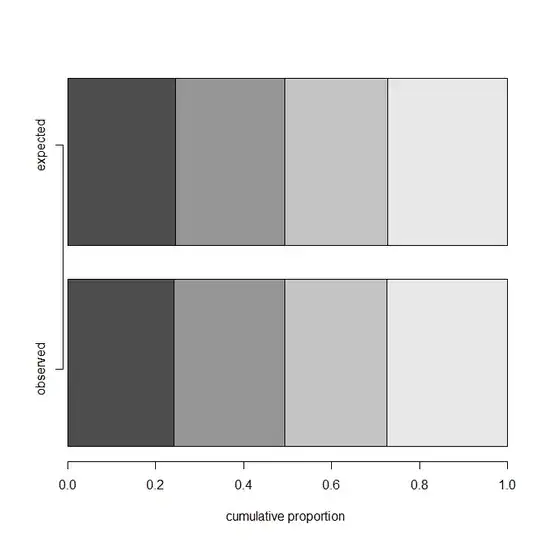@NickCox has done a good job pointing out that your expected values don't match your observed values, in that they don't sum to the same total. But I gather your question is motivated by surprise that the chi-squared test is significant (which holds even with the presumably correct expected values), given that the proportions seem so similar.
x = matrix(c(11294,11830,10820,12875, 11464.50625,11668.22015,10954.68822,12731.58537),
nrow=2, byrow=T)
p = apply(x, 1, function(y){ y/(.5*sum(x)) })
t(p)
# [,1] [,2] [,3] [,4]
# [1,] 0.2412269 0.2526752 0.2311028 0.2749952
# [2,] 0.2448687 0.2492198 0.2339795 0.2719320
chisq.test(x[1,], p=p[,2])
# Chi-squared test for given probabilities
#
# data: x[1, ]
# X-squared = 8.0504, df = 3, p-value = 0.04498
windows()
barplot(p, horiz=T, xlab="cumulative proportion")
axis(side=2, at=c(.66,2), labels=c("observed", "expected"))

This reflects a very common misunderstanding of the nature of hypothesis testing and $p$-values. It is true that the proportions are very similar, but they are not identical—they differ at the third decimal place. Moreover, you have an enormous amount of data ($N = 46819$). When you test a hypothesis (e.g., by running a chi-squared test), the $p$-value conflates how far your data are from the expected values with how uncertain you are that the difference exists. Because you have so much data, in your case we can be reasonably certain that data as far (not very!) from the null are somewhat unlikely. This is simply the way hypothesis testing works when you have very large $N$ (see this excellent CV thread: Why does frequentist hypothesis testing become biased towards rejecting the null hypothesis with sufficiently large samples?). In other words, there is nothing to "fix" in your results (other than the inconsistent values).
If you are interested in a measure of how far your observed values are from the expected values that is uncontaminated by $N$, you could use the Cramer's $V$ for a goodness of fit test (see @Alexis' answer here: Understanding $χ2$ and Cramér's $V$ results):
$$
{\rm Cramer's}\ V = \sqrt{\frac{\chi^2}{N}} = \sqrt{\frac{8.0504}{46819}} = 0.013
$$
